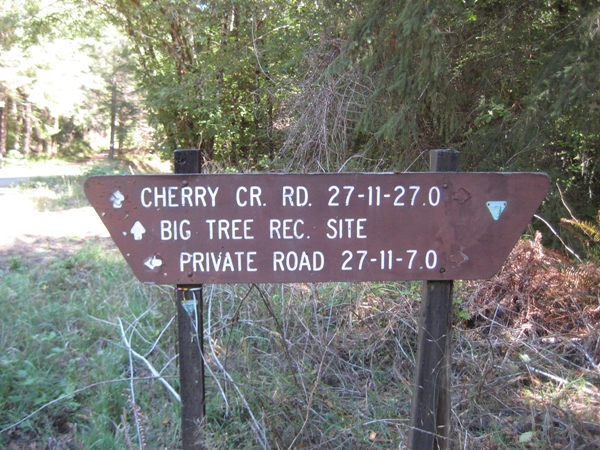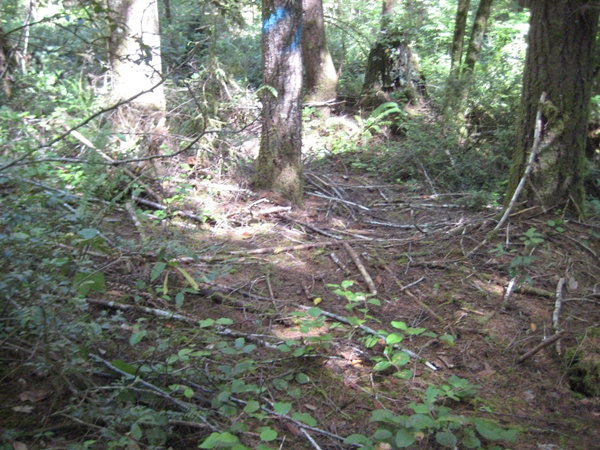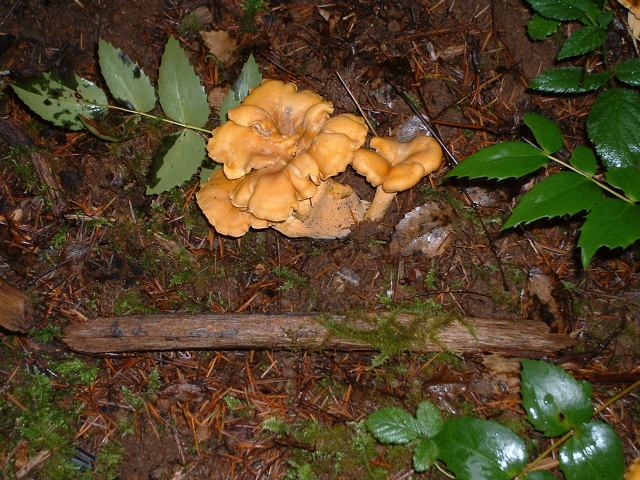It’s true that the Pacific Northwest is a mushroom wonderland, but mercifully, the many varieties are spread throughout the year well – but my favorite season for mushrooming hereabouts is the fall. It’s not because autumn brings my favorite mushrooms, because there are probably 6 or more that I appreciate finding more than chanterelles, the most common of the fall mushrooms locally. But autumn brings a magic to the forest that is absent in any other season, and just going out and tromping through the woods brings a spiritual high – the smells, the filtered sunlight, the colors, the soft breezes – all these things combine to make a fall hike in the woods a “must-do” activity for all mankind – and while you’re there, why not look for something to make dinner that much better?

Yesterday, San and I packed a lunch and renewed the prep for a forest hike (you don’t just “go” – there’s a lot of things necessary to make your adventure safe, enjoyable, and successful.). Once ready, we jumped into the SUV and slipped of town on the 20 mile rural dirt route out to the BLM (Bureau of Land Management) tract at Cherry Creek in the Coastal Range. The ride itself is a joy, and the Oregon Indian Summer makes it all the more pleasurable.
As we arrive at our chosen “spot” (all ‘shroomers have spots that they check all the time!), we of course see no one else – it’s surprising how little picking pressure that occurs in these woods – in my 5+ years of mushrooming, I can only remember bumping into another picker one time – but I often see evidence of others having been around – you find that mushrooming hones your Indian sensitivities for the natural world, and you know right away when things don’t look “natural”.
On this day, I took along my camera and spent a good deal of time getting some shots of the process of ‘shrooming – I think it’ll be fun to put together a photo report of the trip, along with some hopefully interesting narrative to go along. Let’s go!

I don’t know why this area warrants such nice signage, but not all BLM tracts have such fancy signs as this – the usual signage, if it exists at all, is a small (maybe 6” x 18”) horizontal, T shaped brown wooden sign with a series of three numbers, such as this one 27-11-27.0 (these numbers represent the legal description of the area the road goes through, as well as the road ID.). These signs and their numbers become important to crews fighting fires, or logging crews, or anyone who gets lost in the woods – I’ve been saved by them many times! If instead, you find a vertical post with a four digit number, that means it’s an unimproved logging road – tough going! Any good forest map will have these numbers noted on most listed roads – forest maps are fascinating!

This is the usual forest floor of the areas I mushroom in – this is what I consider an “open” floor, meaning there is minimal undergrowth, and that you can get around easily – this is average stuff, it can be much nicer than this, but not often. The blue paint on the tree at the top of the pic means that tree will soon be thinned – the stump to the right of that tree means that this is at least a second growth (replanted) forest.

Here’s some tighter going! But ‘shroomers may choose to pick here rather than an easy area, because they know that other pickers (like me) would not pick here. Actually, this isn’t that bad, it’s just the thickest growth I had a pic of. However, there are plenty of places I wouldn’t pick in!

Here’s the first mushroom I found – it’s a white chanterelle – trust me! I’ll tell you later how I know. I also know this is an OLD mushroom – only old mushrooms have mold on them. We had a rain of an inch back in July, and I’ll bet this one popped from that rain – most ‘shroomers will agree that mushrooms are motivated to bloom by moisture, and that until we see regular rains, we won’t see many mushrooms.

Here’s the second one – it’s displaying a typical white chanterelle behavior -a mushhump! A mushhump is a bulge in the forest duff indicating that there’s a mushroom under there slowly pushing its way out. White chanterelles take a longer time to emerge, and have shorter stalks than do their cousins, the yellow chanterelles.




And here are four more semi mushhumps that were found in the same general area as those above – it’s quite common to find many mushrooms in one small place – so if you find a mushroom, spend a good deal of time looking carefully all around close by for more – they’re likely more there.
There are a few other clues that nature gives you to help you find more chanterelles – you can look for the symbiotic partners and affinities that the mushroom has in the forest – what to look for? Well, start with the Douglas Fir, the most common tree in the forest of the Pacific Northwest – any tree you see in any of these photos will be a Douglas Fir – and Doug Fir and chanterelles benefit each other, and so are found together.

Then there are some shrubs in the undergrowth to look for as well – this is Evergreen Huckleberry, a beautiful shade plant, and one that chanterelles -especially whites- like to hide under. Evergreen Huckleberry also bears delicious fruit, but it must have a little sun to do that – so if you want to try some of its berries, mid September is a good time – but look on the edge of the forest, not in the shade – and watch out for hungry bears! Ha.

Now, if I can find a place that has all the above, and a moss floor, I’m in heaven – I’ll spend the next hour on my hands and knees here – ’cause I know if there are any chanterelles around, they’ll be here! Moss and chanterelles are in love with each other! And this is lovely stuff, isn’t it? If I could, I’d grow it in my living room.

Here’s the same stuff, up close and personal – it’s either Lanky Moss or Pipecleaner Moss, but damn, there are hundreds of mosses, and … what the hell. I love it anyway. Looks like shag carpet, doesn’t it!

After gathering about 2 pounds of mushrooms in this relatively low elevation (about 200′), we decided to check another spot at a higher elevation – I don’t know why the area deserves this fancy sign, since the road doesn’t really go anywhere, and in fact is closed 2 miles up (the road “washed” away and they never replaced it) – but it does rise quickly. My spots are about 2000′ high here, and mushrooms are known to bloom sooner at higher elevations, so there was a good chance our timing might be perfect.

I love the forest floor in this area – there’s almost no undergrowth at all, just needles everywhere. But the trees are about the same age as they are down lower, where there is much more undergrowth – Why? Don’t know for sure, but it may have something to do with the elevation – they are both second growth forest, but this area had much larger, old growth trees growing when it was cut. And we know that this area was the scene of a huge fire before they cut down those huge old growth trees – here’s how we know.

Look at this trunk – it’s obvious it was an old growth tree – and it’s obvious it burned before they cut it down – in a really severe fire, the trees will be killed, so harvesting always occurs soon after – that’s apparent in this forest, and from the size of the current trees, we can estimate that that fire took place about 25 years ago.

But did we find any mushrooms here? Yes and No – the ground was covered with what are called, “pinheads” – tiny yellow chanterelles, such as those above. The yellows emerge in a different fashion than do the whites we found down lower – they seem to pop up above the surface of the duff in an immature state, and depending on the amount of moisture available, they either grow quickly, or just sit there waiting for more rain. These are really tiny, note the size of the needles. So, we did no picking here – and soon called an end to a delightful day spent in the beautiful woods.
And as I draw this really long post to an end, I’m going to tell you how to tell the difference between a yellow and a white chanterelle. Here are two views of the whites I gathered yesterday.


First of all, a white chanterelle is really cream colored, not really white – these we know are old mushrooms, because they have the characteristic brown scaring that old white chanterelles get – yellow chants tend to not get this scaring – so immediately you know if you see brown scaring, you have a white chanterelle. Also, when you see debris glued to the top of the mushroom, that’s another clue that it’s been there for awhile.
In the top pic, the gills or veins are quite distinct from any other mushrooms – they are blunt and wider spaced than the usual sharp gills of most mushrooms – this fact may not help determine the difference between a white and yellow chanterelle, but it will help you to know you have found a safe and eatable mushroom – no other mushroom in our woods looks like this. Let’s look at a few yellow chants from a previous hunt to see how they differ.


If you say, “they’re not yellow”. I’ll agree – the color of chanterelles can go from a creamy white to a dark brown – and the yellows can be anything from a light beige right on through all the shades of yellow, orange, red, and brown – but the color above is the usual color for what we know as yellow chanterelles. The shape, however, is another story – here is a more classic vase chanterelle shape, in a pic I borrowed from the US Forest Service.

If all yellow chants looked just like this one, no one would ever have a problem identifying them – but as you can see from the other pics above, there is quite a variation in shape, as well as color, among the species – so the shape will probably not help you determine if it’s a white or yellow chanterelle – but, does it really matter? They all taste the same, and they are all eminently eatable.
Find ’em, pick ’em, and enjoy ’em – just remember fall is the time to be out in the woods! Get out there.

